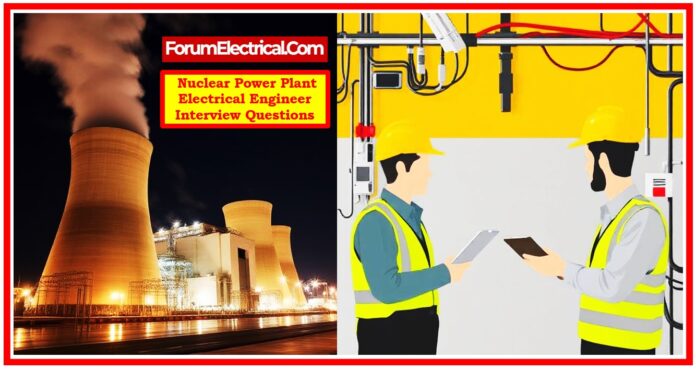1). What is the role of an electrical generator in a Nuclear Power Plant?
The generator uses electromagnetic induction to transform the steam turbine’s mechanical energy into electrical energy.
2). How is electricity distributed in a Nuclear Power Plant?
- Unit auxiliary transformers (UAT),
- Station transformers, &
- Switchgear
provide power to auxiliaries and the grid.
3). What types of Switchgear are utilized in Nuclear Power Plants?
- Metal-clad,
- Gas-insulated (GIS), &
- Air-insulated switchgear (AIS)
are commonly employed based on voltage levels and reliability requirements.
4). Explain the significance of Class 1E Power Systems
Class 1E systems are electrical systems that ensure the plant’s safe shutdown & emergency operations.
5). What types of Protective Relays are generally utilized in Nuclear Power Plants?
- Differential protection, overcurrent relays,
- Earth fault, under/overvoltage relays, &
- Reverse power relays
are frequently employed.
6). Describe how a Nuclear Power Plant’s UPS system works
During power outages, the UPS delivers continuous DC/AC power to important instruments and control equipment.
7). Why are Redundant Power Supply necessary in Nuclear Power Plants?
Redundancy guarantees that safety systems continue to operate without interruption, preventing failure during grid outages (or) internal failures.
8). What are the Primary Electrical Components of a Nuclear Reactor Building?
The Primary Electrical Components of a Nuclear Reactor Building includes
- MCCs,
- Motor drives,
- Control cables,
- Transformers,
- Lighting,
- Grounding, and
- Instrument panels.
9). Describe the Purpose of Grounding in a Nuclear Reactor
Grounding provides fault current paths, protects personnel, & guarantees that protective systems operate correctly.
10). What kind of Batteries are utilized in Nuclear Plants, and why?
VRLA (or) Ni-Cd batteries are employed due to their dependability, lengthy backup time, & low maintenance.
11). What is the importance of Cable Tray systems in Nuclear Power Plants?
They provide mechanical support & routing for power, control, & instrumentation cables while ensuring fire zones and isolation.
12). How does a Nuclear Power Plant ensure the integrity of its Cable Insulation?
Nuclear plant ensure the integrity of its cable insulation using megger testing, high-potential testing (Hi-Pot), & insulation resistance monitoring.
13). What is a Motor Control Centre (MCC)?
An MCC is a centralized system that manages several electric motors and comprises starters, overload relays, & breakers.
14). How are Transformers tested in Nuclear Power Plants?
Transformers tested in nuclear power plants Includes
- IR testing,
- Turns ratio testing,
- Vector group verification,
- Oil testing, and
- Temperature increase testing.
15). What is the purpose of Emergency Diesel Generators (EDG)?
EDGs offer backup power to safety-related systems in the case of a grid breakdown or blackout.
16). How are Motors classified in Nuclear Plants?
Motors classified in nuclear plants according to its application (safety-related or not), enclosure type (TEFC, WP), & voltage rating.
17). What kind of Motors are utilized to Control Valves in Nuclear Power Plants?
Servo (or) stepper motors with position feedback are used for accurately positioning valves.
18). Explain the employment of Current & Potential Transformers (CTs & PTs) in Nuclear Power Plants.
CTs & PTs are used for metering & protection, reducing high voltage/current to quantifiable values.
19). What is the Reactor Protection System (RPS)?
RPS monitors reactor conditions and executes a safe shutdown in abnormal situations, using Class 1E systems.
20). What Standards control the electrical systems in Nuclear Power Plants?
IEEE, IEC, and NRC regulations govern the design, testing, & maintenance of electrical systems in the nuclear plants.
21). What steps do you take to ensure Electrical Isolation during Maintenance?
To ensure electrical isolation during maintenance:
- By implementing Lockout/Tagout (LOTO) procedures,
- Isolators, and
- Validating the absence of voltage.
22). What is the function of the Primary Transformer in a Nuclear Power Plant?
The function of the primary transformer in a nuclear power plant is to increases the voltage generated by the generator to transmission levels for grid distribution.
23). Describe the usual Earthing System found in a Nuclear Reactor
A TN-S or TT system with mesh and rod earthing is used to protect equipment, neutral, and lightning.
24). What types of Lighting Systems are employed in Nuclear Plants?
In critical zones, normal, emergency, & task lighting systems are installed.
Ex: LED (or) explosion-proof fixtures.
25). What is the Arc Flash Hazard, and how is it Mitigated?
Arc flash is a high-energy failure that causes an explosion; it is minimized by
- Arc-resistant gear,
- Relays,
- Personal protective equipment (ppe), and
- Maintenance practices.









